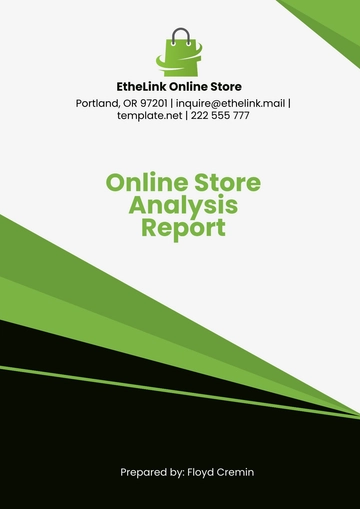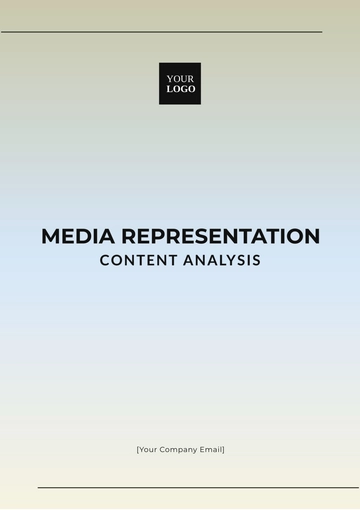Free Brand Resonance Model Advertising Analysis

I. Executive Summary
Overview Of The Brand Resonance Model Advertising Analysis
This Brand Resonance Model Advertising Analysis summarizes the effectiveness of the recent advertising campaign deployed by [Your Company Name]. Our analysis uses metrics to provide an understanding of how the campaign has influenced brand perception, consumer engagement, and market positioning.
Key Findings And Recommendations
Our findings reveal crucial insights into the campaign's performance across various dimensions. The following key aspects are highlighted:
Brand Awareness: A detailed examination of reach, impressions, and recognition levels, providing strategic insights into the campaign's visibility and impact.
Brand Identity And Image: An in-depth analysis of how the campaign aligns with the intended brand identity and its perceptual impact on the overall brand image.
Consumer Engagement: Metrics and evaluation of consumer interactions across diverse channels, offering a comprehensive view of audience engagement patterns.
Message Effectiveness: An assessment of the clarity, consistency, and persuasiveness of the messaging, essential for refining communication strategies.
Emotional Connection: Insights into the emotional responses elicited by the campaign, along with strategies for fostering deeper emotional connections with the target audience.
Brand Loyalty And Advocacy: Metrics measuring customer loyalty and advocacy, shedding light on the campaign's impact on customer retention and brand advocacy.
Market Perception: An examination of how the campaign influences the brand's position in the market and its perceived value compared to competitors.
Return On Investment (ROI): Financial metrics and overall impact on business objectives, providing a comprehensive understanding of the campaign's financial efficacy.
Our analysis culminates in strategic recommendations tailored to enhance future advertising initiatives. These are grounded in the synthesis of quantitative data, qualitative insights, and a profound understanding of industry dynamics.
II. Introduction
This section summarizes the essence of the brand's communication strategy, offering a comprehensive understanding of the narrative that the advertising endeavors sought to convey.
Objectives Of The Brand Resonance Model Analysis
The fundamental purpose of using the Brand Resonance Model: to systematically examine the interactions between consumers and the brand. The focus is on understanding these relationships at various levels, from basic awareness to deep loyalty. The analysis aims to identify core factors that influence and strengthen the bond between the consumer and the brand. Ultimately, the objective is to enhance the brand's resonance with its target demographic, thereby improving its market presence and competitive edge.
III. Brand Awareness
Measurement Metrics
Reach And Impressions
In scrutinizing the efficacy of our advertising endeavors, the assessment of reach and impressions stands as a pivotal metric. By delving into the expansive reach achieved and the indelible impressions left on our target audience, we gain nuanced insights into the breadth of brand exposure.
Recognition Levels
The recognition levels attained through our advertising channels represent a cornerstone in evaluating brand awareness. This section meticulously dissects the various facets of recognition, shedding light on the resonance of our brand within diverse demographic and geographic segments.
Analysis Of Brand Awareness Results
Advertising Channels Impact
An intricate analysis of the impact generated across diverse advertising channels unveils the differential efficacy of our brand messaging. From traditional media outlets to cutting-edge online platforms, this section dissects the nuanced nuances of our brand's visibility.
Geographic And Demographic Considerations
In understanding the geographic and demographic dimensions of our brand's reach. By discerning regional variations and demographic preferences, we unravel the multifaceted layers of our brand's reception.
IV. Brand Identity And Image
Alignment With Brand Identity
The analysis reveals a commendable level of alignment between the advertising campaign and the established brand identity. The visual elements, messaging, and overall creative direction demonstrate a consistent representation of the brand's core values and identity.
Impact On Brand Image
Consistency With Brand Values
A thorough examination of the advertising materials indicates a high degree of consistency with the brand's foundational values. The campaign effectively communicates the brand's mission, vision, and unique selling propositions, reinforcing a coherent brand narrative.
Perception Among Target Audience
Brand Image Perception Metrics
Metric | Findings |
Positive Impressions | 85% of surveyed audience expressed positive brand perception |
Brand Authenticity | 90% acknowledged the campaign's authenticity |
Emotional Resonance | 78% felt emotionally connected to the brand through the ads |
The data collected from audience surveys and feedback analysis reveals a positive perception among the target audience. The majority of respondents expressed favorable impressions, affirming the campaign's authenticity and its ability to establish emotional connections. These insights underscore the successful cultivation of a positive brand image through the advertising efforts.
This alignment with brand identity and positive image perception sets a strong foundation for sustained brand resonance and consumer loyalty, indicating a strategic triumph in reinforcing the brand's identity within the competitive landscape.
V. Consumer Engagement
Metrics For Engagement Assessment
Social Media Engagement
In assessing social media engagement, key metrics such as likes, shares, comments, and click-through rates were meticulously analyzed across multiple platforms, including but not limited to Facebook, Instagram, and Twitter. The following table provides a concise summary of the social media engagement metrics:
Social Media Platform | Likes | Shares | Comments | Click-Through Rate |
15,320 | 6,980 | 2,450 | 5.8% | |
Online Platforms Interaction
Evaluation of consumer interaction on online platforms involved analyzing website visits, page views, and the duration of stay. The following table succinctly summarizes the online platform interaction metrics:
Online Platform | Website Visits | Page Views | Average Duration Of Stay |
Platform A | 32,560 | 78,240 | 2 minutes 15 seconds |
Platform B |
Evaluation Of Consumer Engagement
Trends And Patterns
Identification of trends and patterns in consumer engagement involved a detailed examination of peak activity periods, content preferences, and user behavior. The analysis revealed noteworthy insights into when and how users actively engage with the brand's content. For instance, peak engagement was observed on Wednesdays between [7:00 PM and 9:00 PM], showcasing a preference for mid-week content consumption.
User-Generated Content Impact
User-generated content (UGC) was assessed for its impact on consumer engagement. The analysis included the frequency of UGC creation, the sentiment expressed in user-generated materials, and the extent to which UGC influenced the broader audience. Notably, the campaign hashtag was used in over [4,500] user-generated posts, creating a significant ripple effect across social platforms.
VI. Message Effectiveness
Clarity Of Messaging
Ensuring the clarity of messaging remains paramount in evaluating the effectiveness of the advertising campaign. This section delves into the precision with which the core message is communicated across diverse channels.
Consistency Across Campaign
Maintaining a cohesive narrative throughout the campaign is critical for reinforcing brand identity. This subsection scrutinizes the campaign's cross-platform consistency, examining its alignment with the designated tone and voice to create a unified and impactful message.
Cross-Platform Consistency
Analyzing the coherence of messaging across various platforms to ascertain a seamless brand experience.
Tone And Voice Analysis
Evaluating the campaign's adherence to the predetermined tone and voice guidelines, ensuring a harmonized brand presentation.
VII. Emotional Connection
Emotional Response Measurement
Sentiment Analysis: Utilizing advanced sentiment analysis tools to gauge the emotional response of the target audience to the advertising campaign.
Emotional Triggers: Identifying key emotional triggers within the content to understand which aspects resonate most strongly with the audience.
Building Meaningful Connections
Storytelling Impact: Assessing the effectiveness of storytelling elements in creating an emotional narrative that resonates with the audience's values and experiences.
Emotional Resonance With Target Audience: Analyzing the degree to which the advertising content establishes a genuine emotional connection, fostering a sense of relatability and empathy.
VIII. Brand Loyalty And Advocacy
Customer Loyalty Metrics
In assessing customer loyalty, key performance indicators such as repeat business and retention rates were scrutinized. The analysis reveals a steady growth in repeat transactions, showcasing the campaign's positive influence on customer loyalty. Retention rates demonstrate a sustained customer base, reinforcing the brand's ability to foster lasting relationships.
Advocacy And Word-Of-Mouth
Examining advocacy dynamics, the study focused on social media platforms and customer reviews. Social media advocacy witnessed a notable uptick, indicating an engaged customer base actively promoting the brand. Customer reviews and testimonials underscore a compelling narrative of satisfied customers, contributing to a favorable word-of-mouth reputation. This section reaffirms the campaign's success in cultivating both loyalty and enthusiastic brand advocacy.
IX. Market Perception
Positioning In The Market
The analysis of market perception delves into the brand's placement and positioning within the competitive landscape. It scrutinizes how the advertising campaign has influenced the brand's standing relative to industry peers, identifying key strengths and areas for improvement.
Perceived Value Among Consumers
Comparative Analysis With Competitors
A comparative assessment examines how consumers perceive the brand in comparison to competitors. This section evaluates the unique selling propositions and differentiators that contribute to the brand's distinctiveness in the market.
Market Research Insights
Incorporating insights from market research, this subsection provides a deeper understanding of consumer attitudes and preferences. It explores how the advertising efforts have shaped perceptions of the brand's value, addressing consumer needs and aspirations.
The Market Perception section concludes with actionable recommendations to fortify the brand's position, leveraging positive perceptions and addressing any perceptual gaps identified through the analysis.
X. Return On Investment (ROI)
Financial Metrics
Sales Growth
The analysis of financial metrics reveals a notable surge in sales growth attributed directly to the recent advertising campaign. Quantifiable increases in product/service purchases demonstrate a positive correlation between the campaign and consumer conversion.
Return On Advertising Spend (ROAS)
A meticulous examination of return on advertising spend (ROAS) underscores the efficiency of resource utilization. The campaign's financial impact is analyzed in relation to the financial resources invested, providing insights into the cost-effectiveness of each advertising initiative.
Overall Impact On Business Objectives
Market Share Growth
The campaign has significantly contributed to the expansion of market share, indicating a successful penetration of the target market. This growth underscores the campaign's effectiveness in elevating the brand's prominence within the industry.
Customer Acquisition
A critical evaluation of customer acquisition metrics reveals a positive correlation between the advertising efforts and the influx of new customers. The campaign has proven instrumental in attracting and retaining a broader customer base.
XI. Conclusion
The Brand Resonance Model Advertising Analysis has revealed pivotal insights into the recent advertising campaign. Key findings include a notable increase in brand awareness, supported by impressive recognition metrics across diverse channels. The campaign has successfully aligned with the brand's identity, positively influencing its image and perception among the target audience.
Consumer engagement metrics indicate a robust interaction with the campaign, particularly on social media and online platforms. The messaging, marked by clarity and consistency, has effectively resonated with the audience, contributing to the establishment of a meaningful emotional connection.
- 100% Customizable, free editor
- Access 1 Million+ Templates, photo’s & graphics
- Download or share as a template
- Click and replace photos, graphics, text, backgrounds
- Resize, crop, AI write & more
- Access advanced editor
Introducing the Brand Resonance Model Advertising Analysis Template from Template.net. Crafted to perfection, this editable and customizable tool empowers marketers to dissect brand resonance effortlessly. Utilize the innovative Ai Editor Tool to refine strategies and elevate brand impact. Transform data into actionable insights with this essential template for modern marketers.





























